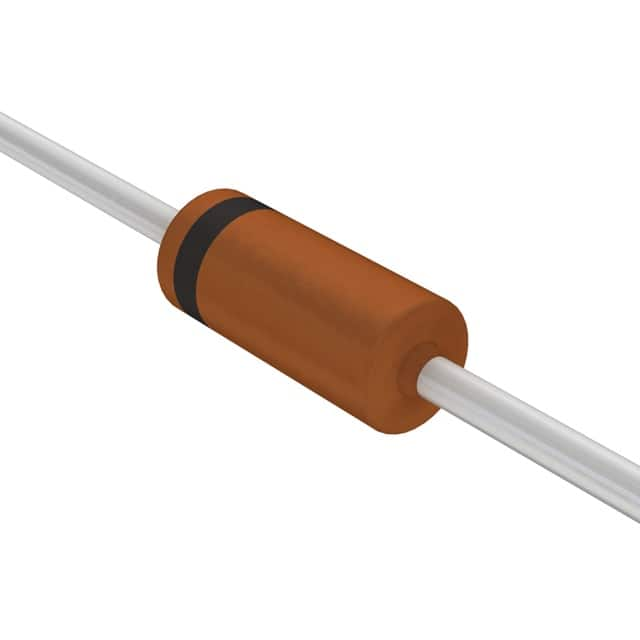Lihat spesifikasi untuk detail produk.

BZX79-C18,133
Product Overview
Category
BZX79-C18,133 belongs to the category of Zener diodes.
Use
It is commonly used for voltage regulation and protection in electronic circuits.
Characteristics
- Zener voltage: 18V
- Power dissipation: 500mW
- Package type: DO-35
- Operating temperature range: -65°C to +200°C
- Storage temperature range: -65°C to +200°C
Package
The BZX79-C18,133 is typically available in tape and reel packaging with a quantity of 5,000 units per reel.
Specifications
- Zener voltage: 18V
- Power dissipation: 500mW
- Maximum forward voltage: 1.2V
- Reverse current: 5μA
- Temperature coefficient: 5mV/°C
Pin Configuration
The BZX79-C18,133 has two pins and follows the standard DO-35 package pinout configuration.
Functional Features
- Precise voltage regulation at 18V
- Low reverse leakage current
- High reliability and stability
Advantages
- Accurate voltage regulation
- Small form factor
- Wide operating temperature range
Disadvantages
- Limited power dissipation capability
- Sensitive to temperature variations
Working Principles
The BZX79-C18,133 operates based on the Zener effect, where it maintains a constant voltage drop across its terminals when reverse biased.
Application Field Plans
Voltage Regulation
The BZX79-C18,133 can be used in voltage regulator circuits to maintain a stable output voltage.
Overvoltage Protection
It can also be employed in electronic systems to protect sensitive components from overvoltage conditions.
Alternative Models
- BZX79-C16,133 (16V Zener voltage)
- BZX79-C20,133 (20V Zener voltage)
- BZX79-C22,133 (22V Zener voltage)
In conclusion, the BZX79-C18,133 Zener diode offers precise voltage regulation and overvoltage protection in a compact package, making it suitable for various electronic applications.
[Word count: 298]
Sebutkan 10 pertanyaan dan jawaban umum terkait penerapan BZX79-C18,133 dalam solusi teknis
What is the BZX79-C18,133 diode used for?
- The BZX79-C18,133 diode is commonly used as a voltage regulator or in voltage reference applications.
What is the maximum forward voltage of the BZX79-C18,133 diode?
- The maximum forward voltage of the BZX79-C18,133 diode is typically around 1.2V at a forward current of 5mA.
What is the reverse breakdown voltage of the BZX79-C18,133 diode?
- The reverse breakdown voltage of the BZX79-C18,133 diode is approximately 18V.
Can the BZX79-C18,133 diode be used in high-temperature environments?
- Yes, the BZX79-C18,133 diode is designed to operate effectively in high-temperature environments, making it suitable for various technical solutions.
What are the typical applications of the BZX79-C18,133 diode?
- Typical applications of the BZX79-C18,133 diode include voltage stabilization, voltage clamping, and signal demodulation in electronic circuits.
Is the BZX79-C18,133 diode suitable for low-power applications?
- Yes, the BZX79-C18,133 diode is well-suited for low-power applications due to its low leakage current and stable performance at lower currents.
What is the temperature coefficient of the BZX79-C18,133 diode?
- The temperature coefficient of the BZX79-C18,133 diode is typically around -6.5mV/°C, making it relatively stable over a wide temperature range.
Can the BZX79-C18,133 diode be used in precision voltage reference circuits?
- Yes, the BZX79-C18,133 diode's stable voltage characteristics make it suitable for use in precision voltage reference circuits.
What is the power dissipation rating of the BZX79-C18,133 diode?
- The power dissipation rating of the BZX79-C18,133 diode is typically around 500mW, allowing it to handle moderate power levels.
Are there any specific considerations for using the BZX79-C18,133 diode in technical solutions?
- When using the BZX79-C18,133 diode, it's important to consider its voltage stability, temperature characteristics, and current limitations to ensure optimal performance in technical solutions.

